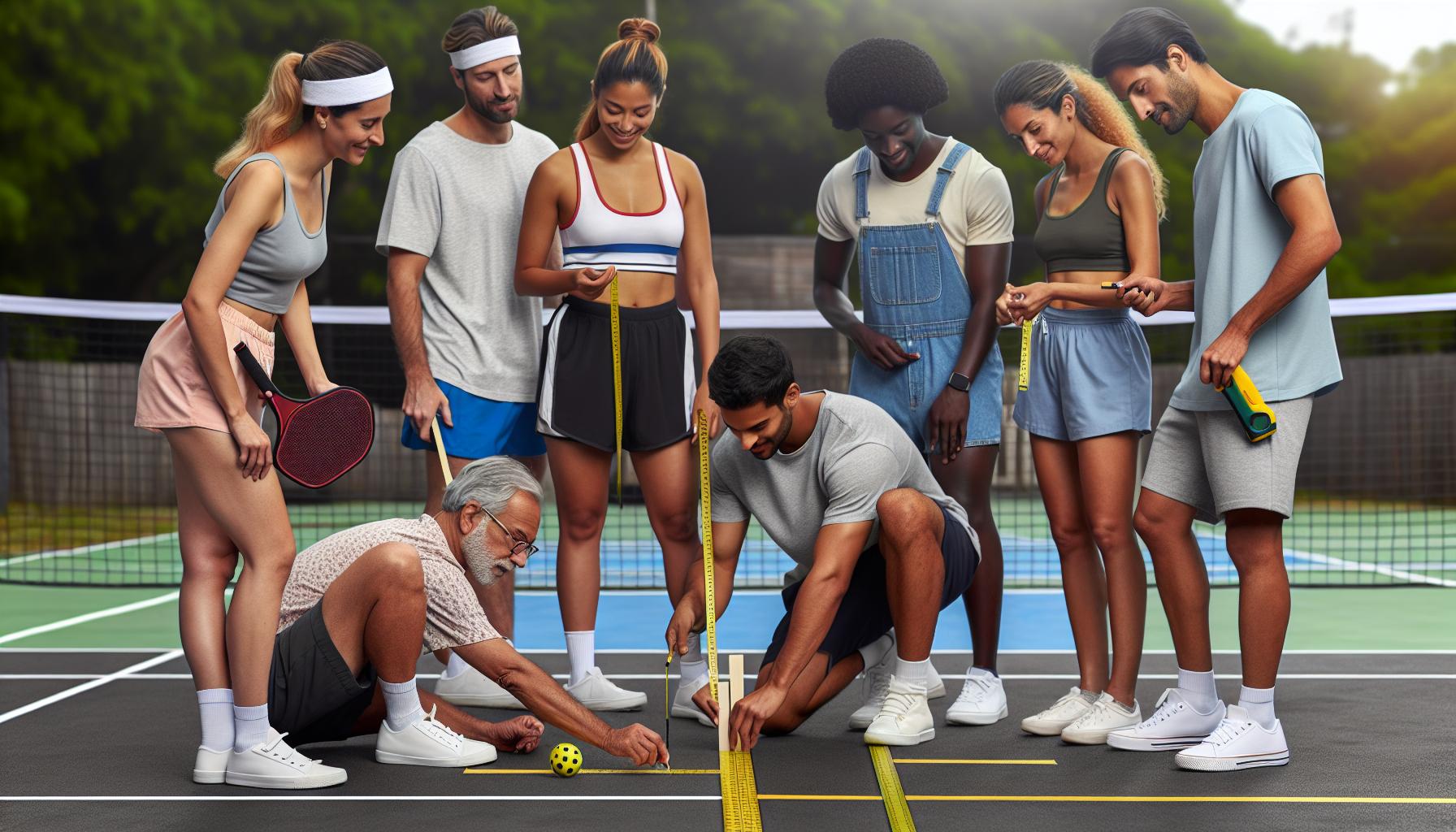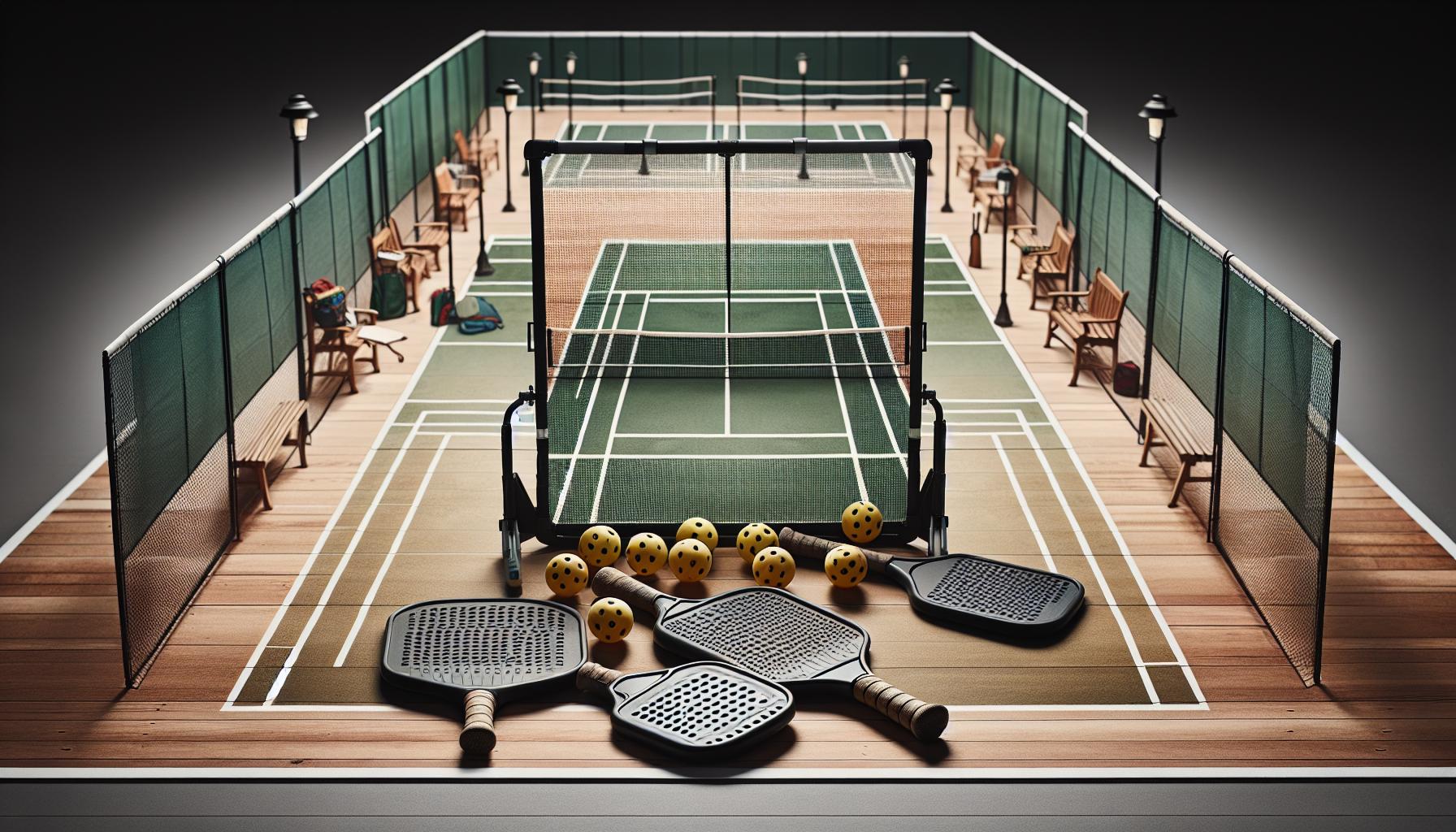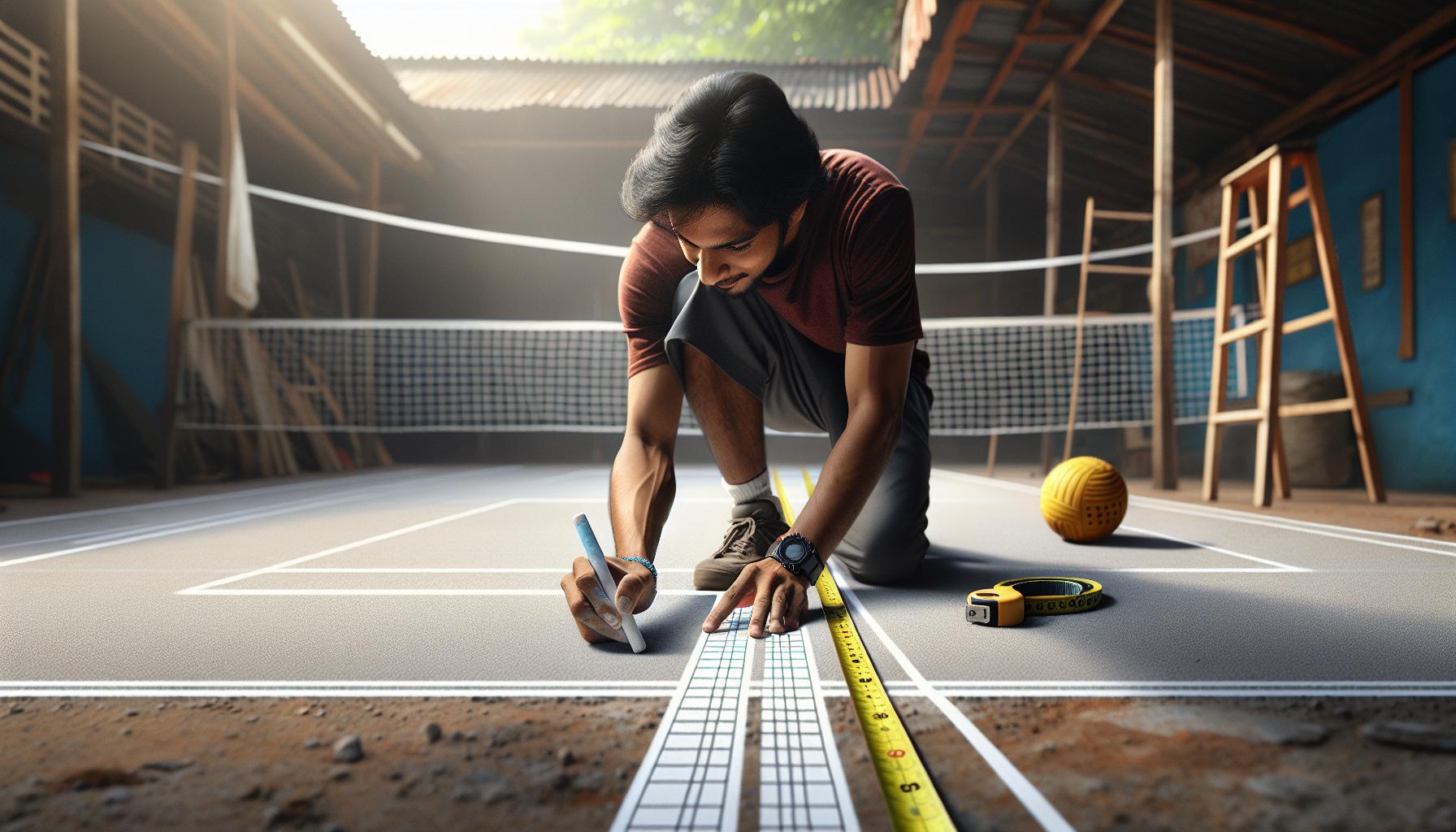Pickleball’s popularity is soaring, and it’s no wonder why. It’s fun, social, and a great way to stay active. But what do you do when there aren’t any courts nearby? No problem! Setting up a temporary pickleball court is easier than you might think. Whether it’s in your driveway, a local park, or even a quiet street, you can get into the game in no time.
In this guide, we’ll walk you through the essentials of creating your own pickleball court. From the right dimensions to the necessary equipment, we’ve got you covered. So grab your paddles, and let’s dive into the world of pickleball. Whether you’re a seasoned pro or just starting out, these guidelines will ensure your temporary court is up to par.
Choose the Right Location
Finding the perfect spot for a temporary pickleball court is the first step toward ensuring an enjoyable game. Flat and spacious areas are ideal, as they provide a safe environment and enough room to move around. Driveways, quiet streets, parks, or even large backyards can serve as excellent choices. However, they must choose a location with minimal disruptions to avoid any hindrances during the game.
Safety is paramount when selecting a location. They should look for areas that are away from busy roads and free of potential hazards like potholes, uneven surfaces, or slippery spots. Lighting is another critical factor, especially if they plan to play in the evening. A well-lit area ensures visibility and reduces the risk of accidents.
Privacy and noise levels are also worth considering. Players would benefit from picking a spot that’s secluded enough to prevent distractions from onlookers or passerby, yet not so isolated that it becomes difficult for players to gather. Moreover, an area with low noise pollution will make communication among players easier, enhancing the overall game experience.
Before finalizing the spot, they need to measure the available space to confirm it can accommodate a pickleball court. Official pickleball courts measure 20 feet in width and 44 feet in length, and an additional buffer of at least 10 feet on all sides is recommended for safety and ease of movement. If the chosen location can’t meet these dimensions, they might need to adjust the court size slightly, though it’s essential to keep it as close to regulation size as possible for a more authentic gameplay experience.
Lastly, the surface of the location plays a crucial role in the game’s quality. Hard, smooth surfaces like asphalt or concrete are preferable as they mimic the conditions of a standard pickleball court. Grass or dirt might not be ideal due to the irregular ball bounce, but they can still be used if no other options are available.
As they scout for the perfect spot, they should take into account the environment’s condition and how it might affect the game. Windy areas can alter the ball’s trajectory, while locations under direct sunlight can make play uncomfortable during hot days. Choosing a spot with natural shade or planning for early morning or late afternoon games can mitigate these concerns.
Determine Court Dimensions

Setting up a temporary pickleball court requires meticulous attention to its dimensions. Pickleball courts mirror the size of a badminton court, measuring 20 feet in width and 44 feet in length, including lines for the non-volley zone, also known as the “kitchen.” These precise measurements ensure a standard playing experience, whether for casual games or competitive matches.
Before laying out the court, it’s important to find a level surface that can comfortably accommodate its size. Ideally, players should allocate additional space around the perimeter for safe movement. Here’s a quick breakdown of the space needed:
| Area | Measurements (in feet) |
|---|---|
| Court Width | 20 |
| Court Length | 44 |
| Non-Volley Zone Depth | 7 |
| Total Space Recommended | At least 34 x 58 |
After confirming there’s enough space, one can start marking the boundaries. Temporary marking solutions such as chalk, tape, or portable court lines work best, as they don’t leave permanent marks on the surface. Those opting for tape should select an outdoor-appropriate variant to ensure visibility and durability, especially if dealing with potentially wet or harsh weather conditions.
When setting up, ensuring visibility of the lines is key. While marking, one should consider the time of day the court will be used. For instance, sunlight can cause glaring issues, making it difficult to see white or light-colored lines. Choosing brightly colored tape or markers can alleviate this problem, enhancing the playing experience for everyone involved.
In addition to the basic dimensions, players should also consider the orientation of the court. Ideally, align the court so that the sun is perpendicular to it during the peak playing hours to minimize the disadvantage of having the sun in one’s eyes. If there’s a prevailing wind direction in the chosen location, setting the court lengthwise against the wind can also help in reducing its impact on the game.
Lastly, for those who are setting up on a multi-use space, such as a shared backyard or a public park, it’s crucial to respect the needs of others who might use the area. Hence, utilizing non-permanent marking solutions and ensuring your setup does not interfere with other activities or damage the surface underscores the respect and consideration needed in shared spaces.
Gather Equipment

After ensuring the dimensions and location of the temporary pickleball court meet the necessary requirements, the next crucial step is gathering the right equipment. Knowing precisely what’s needed not only saves time but also guarantees that the game can be enjoyed without any hitches. The essentials include a net, paddles, balls, and temporary marking materials.
Essential Equipment
The heart of any pickleball setup is the net. A portable net system is ideal for temporary courts as it can be easily set up and dismantled. These nets should meet the standard height of 34 inches in the center and 36 inches at the sides. Alongside the net, players need paddles. While pickleball paddles come in various materials like wood, composite, and graphite, the choice often depends on personal preference and skill level. However, for beginners or those playing casually, any starter paddle will do.
Pickleball balls are specifically designed for the sport, with options for indoor and outdoor play. Outdoor balls are typically harder and have smaller holes, designed to withstand windy conditions and rougher surfaces. Conversely, indoor balls are softer and have larger holes, making them less suited to outdoor play. Selecting the right type of ball is essential for the game’s quality and enjoyment.
Marking the Court
For temporary pickleball courts, marking the boundaries becomes a primary concern. Players can use chalk or painter’s tape for this purpose. Chalk is great for outdoor surfaces like driveways or parking lots where the lines can be washed away. Painter’s tape, meanwhile, is ideal for indoor courts or smooth outdoor surfaces where it can stick well without leaving residues. Whichever material they choose, it’s important that the markings are clear and visible. Players should ensure the lines marking the non-volley zone, also known as the kitchen, are distinct since this area has specific rules.
- Measuring tape ensures that the court dimensions and net height are accurate.
- A sweeping brush or leaf blower might be necessary to clear the playing surface of debris or leaves, ensuring a smooth game.
- If the court setup is in a public area or shared space, signage indicating the temporary use of the area for pickleball can inform and remind others to
Marking the Court

Marking the correct dimensions of a pickleball court is crucial for fair play. Whether it’s in a driveway, a parking lot, or any flat surface, clear boundaries ensure players know exactly what’s in play.
For those setting up a temporary court, the task doesn’t require specialized equipment. With chalk or painter’s tape, one can easily outline the 20’x44′ court dimensions suitable for both singles and doubles play. Here’s a breakdown of the key areas to mark:
- Baseline: The line at the back of the court.
- Sidelines: The lines running parallel to the net on each side.
- Non-Volley Zone (NVZ) or Kitchen: A 7′ area on either side of the net. This zone is critical to mark distinctly as volleys are prohibited within it.
Before starting the marking process, they’ll need a measuring tape to ensure accuracy. Beginning at what will be the net’s location, measure and mark the length and width of the court. Next, measure and mark the NVZ lines. If using chalk, a second pass might be needed to ensure the lines are visible enough. Painter’s tape offers a more vibrant line but might need to be pressed down firmly to stick to the playing surface.
Visibility is key, especially for the NVZ. Consider using a different color or style of marking for this area to help it stand out. This not only aids players during the game but also helps in reducing disputes over whether a ball landed in or out.
Clearing the Playing Surface is another step that should not be overlooked. Before marking, they should remove any debris, stones, or equipment that could affect play or damage the playing surface. It’s also a good time to verify that the surface is flat and safe for game play.
In shared or public spaces, putting up temporary signage can be considerate. These signs can inform others of the temporary pickleball court and its playing times, reducing the likelihood of interruptions and ensuring everyone can enjoy the space respectfully.
For those taking the temporary setup to a community center or park, communication with the facility’s management is key. Some locations may have regulations or require permissions for marking temporary courts. It’s always best to check in advance to avoid any misunderstandings.
Enjoy Your Game

Once your temporary pickleball court is properly set up and clearly marked, it’s time to dive into the fun part—the game itself. Pickleball, known for its friendly and social nature, is a sport that brings people together. Whether you’re playing with friends, family, or neighbors, the joy of the game often lies in the camaraderie and healthy competition.
Players should always warm up before a game to reduce the risk of injuries. A good warm-up includes light jogging around the court perimeter, stretching exercises focusing on the legs, arms, and back, and practicing a few gentle serve and return drills. These activities get the blood flowing and prepare the muscles for the quick movements pickleball requires.
Here are some etiquettes and tips to enhance the game experience:
- Serve Fairly and Consistently: Make sure to serve diagonally across the court and avoid server errors to keep the game flowing smoothly.
- Follow the Rules: Stay familiar with the official pickleball rules, including the intricacies of the Non-Volley Zone (NVZ) and the two-bounce rule which adds a unique twist to how pickleball is played.
- Be Mindful of Shared Spaces: When setting up a temporary court in a shared area, it’s considerate to keep noise levels down and be understanding if others need to use the space.
- Communicate: Clear communication with fellow players not only helps in strategizing but also ensures everyone is on the same page regarding rules and gameplay etiquette.
One of the beauties of pickleball is its accessibility. Players of all ages and skill levels can enjoy the game, with the rules and court size designed to level the playing field, making strategic plays and quick reflexes key components of the game. This inclusivity encourages a diverse group of players to participate, fostering a community atmosphere where everyone is welcome.
While the game is underway, it’s crucial to stay hydrated, especially on hot days. Keep a bottle of water nearby, and take breaks as needed to avoid overheating. Sunscreen and proper attire, such as breathable clothes and comfortable shoes designed for tennis or similar sports, also contribute to a safe and enjoyable playing experience.
For those interested in tracking their improvement or adding an element of competition, consider organizing mini-tournaments or tracking scores over time. This not only adds a fun competitive edge but also allows players to measure their progress and set personal or team goals.
Conclusion
Setting up a temporary pickleball court opens the door to endless fun and camaraderie. It’s not just about playing a game; it’s about embracing a lifestyle that prioritizes health, inclusivity, and sportsmanship. Remembering to warm up and stay hydrated ensures everyone enjoys the game safely. With these guidelines, players of all levels can dive into the joy of pickleball, fostering a community spirit that thrives on fair play and friendly competition. So grab your paddle, wear the right gear, and get ready to serve up some great times on your new pickleball court.














0 Comments